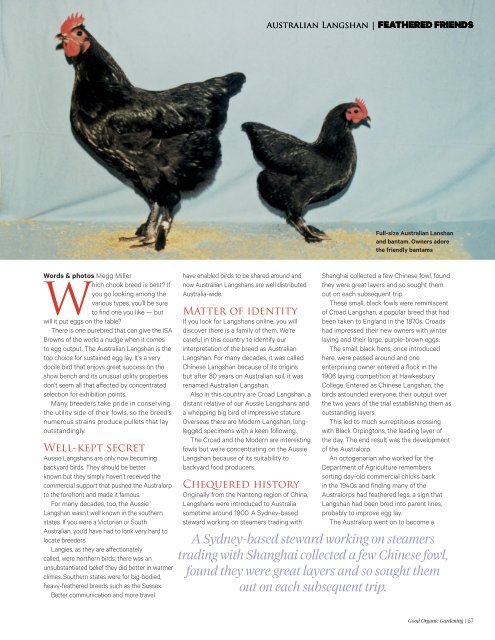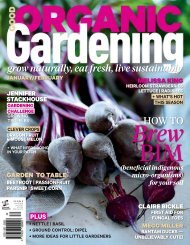3. Good Organic Gardening - May-June 2016 AvxHome.in
3. Good Organic Gardening - May-June 2016 AvxHome.in
3. Good Organic Gardening - May-June 2016 AvxHome.in
Create successful ePaper yourself
Turn your PDF publications into a flip-book with our unique Google optimized e-Paper software.
Australian Langshan | FEATHERED FRIENDS<br />
Full-size Australian Lanshan<br />
and bantam. Owners adore<br />
the friendly bantams<br />
Words & photos Megg Miller<br />
Which chook breed is best? If<br />
you go look<strong>in</strong>g among the<br />
various types, you’ll be sure<br />
to f<strong>in</strong>d one you like — but<br />
will it put eggs on the table?<br />
There is one purebred that can give the ISA<br />
Browns of the world a nudge when it comes<br />
to egg output. The Australian Langshan is the<br />
top choice for susta<strong>in</strong>ed egg lay. It’s a very<br />
docile bird that enjoys great success on the<br />
show bench and its unusual utility properties<br />
don’t seem all that affected by concentrated<br />
selection for exhibition po<strong>in</strong>ts.<br />
Many breeders take pride <strong>in</strong> conserv<strong>in</strong>g<br />
the utility side of their fowls, so the breed’s<br />
numerous stra<strong>in</strong>s produce pullets that lay<br />
outstand<strong>in</strong>gly.<br />
Well-kept secret<br />
Aussie Langshans are only now becom<strong>in</strong>g<br />
backyard birds. They should be better<br />
known but they simply haven’t received the<br />
commercial support that pushed the Australorp<br />
to the forefront and made it famous.<br />
For many decades, too, the Aussie<br />
Langshan wasn’t well known <strong>in</strong> the southern<br />
states. If you were a Victorian or South<br />
Australian, you’d have had to look very hard to<br />
locate breeders.<br />
Langies, as they are affectionately<br />
called, were northern birds; there was an<br />
unsubstantiated belief they did better <strong>in</strong> warmer<br />
climes. Southern states were for big-bodied,<br />
heavy-feathered breeds such as the Sussex.<br />
Better communication and more travel<br />
have enabled birds to be shared around and<br />
now Australian Langshans are well distributed<br />
Australia-wide.<br />
Matter of identity<br />
If you look for Langshans onl<strong>in</strong>e, you will<br />
discover there is a family of them. We’re<br />
careful <strong>in</strong> this country to identify our<br />
<strong>in</strong>terpretation of the breed as Australian<br />
Langshan. For many decades, it was called<br />
Ch<strong>in</strong>ese Langshan because of its orig<strong>in</strong>s<br />
but after 80 years on Australian soil, it was<br />
renamed Australian Langshan.<br />
Also <strong>in</strong> this country are Croad Langshan, a<br />
distant relative of our Aussie Langshans and<br />
a whopp<strong>in</strong>g big bird of impressive stature.<br />
Overseas there are Modern Langshan, longlegged<br />
specimens with a keen follow<strong>in</strong>g.<br />
The Croad and the Modern are <strong>in</strong>terest<strong>in</strong>g<br />
fowls but we’re concentrat<strong>in</strong>g on the Aussie<br />
Langshan because of its suitability to<br />
backyard food producers.<br />
Chequered history<br />
Orig<strong>in</strong>ally from the Nantong region of Ch<strong>in</strong>a,<br />
Langshans were <strong>in</strong>troduced to Australia<br />
sometime around 1900. A Sydney-based<br />
steward work<strong>in</strong>g on steamers trad<strong>in</strong>g with<br />
Shanghai collected a few Ch<strong>in</strong>ese fowl, found<br />
they were great layers and so sought them<br />
out on each subsequent trip.<br />
These small, black fowls were rem<strong>in</strong>iscent<br />
of Croad Langshan, a popular breed that had<br />
been taken to England <strong>in</strong> the 1870s. Croads<br />
had impressed their new owners with w<strong>in</strong>ter<br />
lay<strong>in</strong>g and their large, purple-brown eggs.<br />
The small, black hens, once <strong>in</strong>troduced<br />
here, were passed around and one<br />
enterpris<strong>in</strong>g owner entered a flock <strong>in</strong> the<br />
1906 lay<strong>in</strong>g competition at Hawkesbury<br />
College. Entered as Ch<strong>in</strong>ese Langshan, the<br />
birds astounded everyone, their output over<br />
the two years of the trial establish<strong>in</strong>g them as<br />
outstand<strong>in</strong>g layers.<br />
This led to much surreptitious cross<strong>in</strong>g<br />
with Black Orp<strong>in</strong>gtons, the lead<strong>in</strong>g layer of<br />
the day. The end result was the development<br />
of the Australorp.<br />
An octogenarian who worked for the<br />
Department of Agriculture remembers<br />
sort<strong>in</strong>g day-old commercial chicks back<br />
<strong>in</strong> the 1940s and f<strong>in</strong>d<strong>in</strong>g many of the<br />
Australorps had feathered legs, a sign that<br />
Langshan had been bred <strong>in</strong>to parent l<strong>in</strong>es,<br />
probably to improve egg lay.<br />
The Australorp went on to become a<br />
A Sydney-based steward work<strong>in</strong>g on steamers<br />
trad<strong>in</strong>g with Shanghai collected a few Ch<strong>in</strong>ese fowl,<br />
found they were great layers and so sought them<br />
out on each subsequent trip.<br />
<strong>Good</strong> <strong>Organic</strong> <strong>Garden<strong>in</strong>g</strong> | 67
















